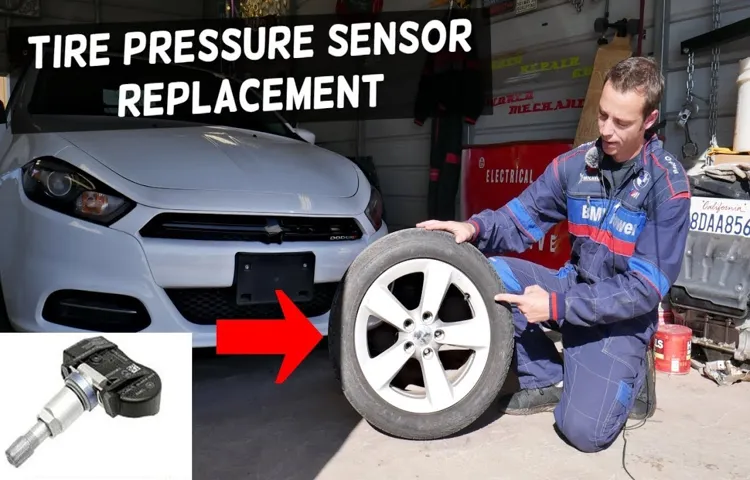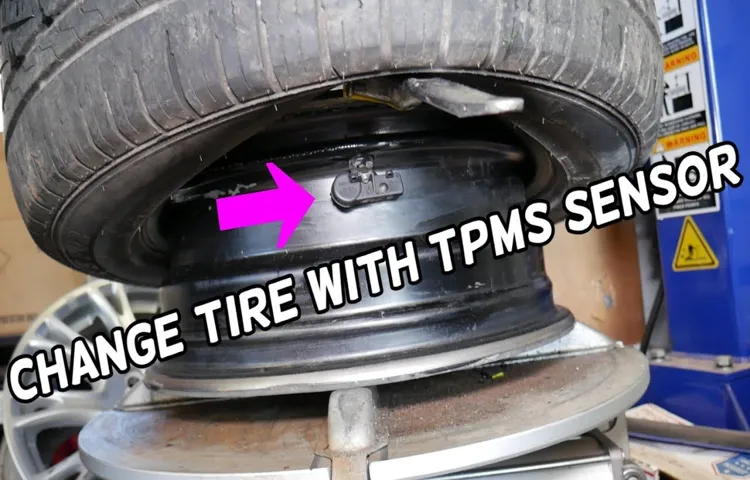Do you ever get bored of driving the same old car and start looking for ways to upgrade it? One small upgrade that can make a big difference is installing a tire pressure sensor. Not only does it give you real-time information about your tire pressure, but it can also help prevent accidents and protect your tires from unnecessary wear and tear. But locating the tire pressure sensor can be a daunting task for those unfamiliar with the mechanics of their vehicle.
Fear not, we have got you covered! In this blog, we will walk you through the process of locating the tire pressure sensor in your car. So sit back, relax, and get ready to upgrade your ride!
Table of Contents
Understanding Tire Pressure Sensors
If you’re wondering where the tire pressure sensor is located, it can typically be found inside the tire valve stem or on the inner side of the wheel. This small device is responsible for monitoring the pressure levels in your tires and alerting you when they are low. It’s an important safety feature that can help prevent accidents and reduce wear and tear on your tires.
Nowadays, most cars come equipped with tire pressure sensors, but it’s always important to check your pressure levels regularly using a tire pressure gauge. Maintaining proper tire pressure not only improves safety but also helps you save money on fuel and extends the life of your tires. So, if you suspect an issue with your tire pressure or sensor, it’s best to have it inspected by a professional as soon as possible.
What is a Tire Pressure Sensor?
A tire pressure sensor is a vital component of modern vehicles that constantly monitors the air pressure in each tire and sends alerts to the driver if the tire pressure falls below the recommended level. The sensor is typically located inside the tire and communicates with the car’s onboard computer system. Maintaining proper tire pressure is crucial for both safety and performance reasons.
Low tire pressure can result in reduced fuel efficiency, decreased handling, and in extreme cases, tire blowouts that can lead to accidents. Thus, having a reliable tire pressure sensor is a must-have for any vehicle owner. It’s imperative to check tire pressure regularly and inflate or deflate the tires as needed to ensure optimal performance.
A tire pressure sensor is like a built-in guardian angel that watches over your vehicle’s tires, keeping you safe and saving you money in the long run.

Types of Tire Pressure Sensors
Tire pressure sensors are important for ensuring that your vehicle’s tires are at the correct pressure to improve safety and performance. In general, there are two types of tire pressure sensors: indirect and direct. Indirect sensors use the vehicle’s anti-lock brake system to calculate tire pressure by measuring wheel revolutions and other data points.
Direct sensors, on the other hand, use pressure monitoring sensors inside each tire to provide real-time data on tire pressure. While indirect sensors are less expensive, direct sensors provide more accurate and timely information. Understanding the type of sensor you have in your vehicle is important for maintaining proper tire pressure and avoiding potential safety hazards on the road.
Locating the Tire Pressure Sensor
If you’re wondering where the tire pressure sensor is located, it’s typically located inside the wheel well. Modern vehicles are equipped with a tire pressure monitoring system that alerts the driver if there’s a problem with the tire pressure. This is thanks to the tire pressure sensor, which is mounted onto the wheel rim of each tire.
The sensor is responsible for monitoring the air pressure levels within the tire and transmitting the data to the car’s computer. Most vehicles have four tire pressure sensors, one for each tire. The sensors are usually not visible from the outside, so you’ll need to remove the wheel to access them.
It’s essential to keep the sensors clean and well-maintained to ensure they perform correctly. Always consult your vehicle’s owner’s manual for specific instructions on how to locate and care for the tire pressure sensor. Overall, knowing where your tire pressure sensors are and understanding how they work can help keep your vehicle running smoothly and safely on the road.
Different Locations for Different Vehicles
When it comes to tire pressure sensors, the location of the sensor can vary depending on the type of vehicle. In some vehicles, the sensor is located inside the tire itself, affixed to the valve stem. This type of sensor is often found in newer vehicles, as it provides more accurate readings of tire pressure.
Other vehicles may have the sensor located outside the tire, near the wheel hub. This type of sensor is often found in older or less expensive vehicles. Regardless of the location, it’s important to regularly check the tire pressure and ensure that the sensor is working properly.
Low tire pressure can lead to decreased fuel efficiency and increased tire wear, so regular monitoring is key to maintaining your vehicle’s performance and safety on the road.
Checking the Owner’s Manual
Checking the owner’s manual is one of the easiest ways to locate the tire pressure sensor in your vehicle. The owner’s manual provides detailed information about your car, including where the tire pressure sensor is located, how to check it, and what to do if it needs repairs. Typically, the tire pressure sensors are located on the wheels themselves or built into the valve stem.
In some instances, the sensor may be located near the wheel hub. The owner’s manual will also provide the recommended tire pressure levels for your car, which can help you maintain the correct tire pressure for optimal performance and safety. With the proper maintenance, your tire pressure sensor can help prevent accidents and extend the life of your tires.
Using a Tire Pressure Sensor Tool
When it comes to checking your tire pressure, using a tire pressure sensor tool can make the process much easier. The first step in using this tool is to locate the tire pressure sensor, which is typically located on the inside of the tire rim. It may be difficult to see without removing the tire, but you can usually feel for it by running your hand along the inside of the tire.
Once you locate the sensor, you can attach the pressure sensor tool to it and get a reading of the current tire pressure. This can help you ensure that your tires are properly inflated, which can improve your vehicle’s fuel efficiency and handling. So, the next time you need to check your tire pressure, consider using a tire pressure sensor tool to make the process quick and easy.
Replacing a Tire Pressure Sensor
If you’ve noticed your tire pressure warning light illuminated on your dashboard, it could be due to a malfunctioning tire pressure sensor. But where is the tire pressure sensor located? Well, it’s typically found inside the tire, mounted to the valve stem. In order to replace it, you’ll need to remove the tire and unseat the tire bead from the rim.
Once that’s done, you can access the sensor and replace it with a new one. It’s important to note that it’s not recommended to reuse the old sensor or try to repair it. Also, make sure to check the battery inside the new sensor as it may need to be replaced as well.
Having a properly functioning tire pressure sensor is crucial for your vehicle’s safety and performance, so don’t hesitate to get it replaced if needed.
When to Replace a Tire Pressure Sensor
Replacing a tire pressure sensor is not an everyday task, but there are times when it becomes necessary. Most modern cars come with sensors that monitor the air pressure in each tire and send alerts to the driver if one or more tires are underinflated. Over time, these sensors can malfunction or wear out, leading to inaccurate readings or complete failure.
The key to knowing when to replace a tire pressure sensor is to look out for warning signs such as a persistent warning light on the dashboard, low tire pressure, or slow response from the sensor. If you notice any of these signs, take your vehicle to a trusted mechanic who can diagnose the problem and replace the faulty sensor as soon as possible. Don’t ignore the issue, as driving with faulty tire pressure sensors puts you and other road users in danger.
By replacing a tire pressure sensor promptly, you can drive safely and ensure that your vehicle’s tires are properly inflated.
Tools Required for Replacement
If you’re experiencing issues with your tire pressure, it might be time to replace the tire pressure sensor. But what tools do you need to get the job done? First and foremost, you’ll need a tire jack and lug wrench to safely raise and lower the car and remove the tire. Once the tire is removed, a valve core tool is needed to release the air from the tire and remove the old sensor.
A torque wrench is also recommended to ensure the sensor is tightened to the proper specifications. Lastly, a TPMS relearn tool is required to reset the system after the new sensor is installed. With these tools on hand, replacing a tire pressure sensor should be a quick and easy task.
Don’t let a faulty sensor bring down your tire pressure – gather your tools and get the job done today.
Conclusion
You know that little light on your dashboard that looks like an exclamation point inside a tire? Well, that’s your tire pressure sensor trying to tell you something important. But where is it located, you ask? We hate to break it to you, but it’s not the kind of sensor you can point to and say, ‘there it is!’ Rather, modern cars typically have individual sensors mounted inside each tire, constantly monitoring the air pressure and transmitting that data to your car’s computer. So, the next time that pesky warning light turns on, don’t just ignore it – check your tire pressures and give a little salute to those sneaky, but important, sensors working hard to keep you safe on the road!”
FAQs
What is a tire pressure sensor?
A tire pressure sensor is a device that measures the air pressure inside the tire and sends the information to the car’s computer system.
How does the tire pressure sensor work?
The tire pressure sensor uses a pressure sensor mounted inside the tire valve stem to detect the air pressure and then sends a wireless signal to the car’s computer system.
Why is the tire pressure sensor important?
The tire pressure sensor is important because it can help improve safety, fuel efficiency, and tire life by alerting the driver to low tire pressure.
How often should I check my tire pressure sensor?
It is recommended to check your tire pressure sensor at least once a month, or before a long trip, to ensure that your tires are properly inflated and safe to drive.
What happens if the tire pressure sensor fails?
If the tire pressure sensor fails, the car’s computer system may not receive accurate tire pressure readings, which could result in decreased safety, decreased fuel efficiency, or tire damage.
Can I replace the tire pressure sensor myself?
It is possible to replace the tire pressure sensor yourself, but it is recommended to have a professional do it to ensure proper installation and calibration.
Where is the tire pressure sensor located?
The tire pressure sensor is typically located inside the tire valve stem, although some vehicles may have them mounted inside the tire itself or on the wheel hub.



